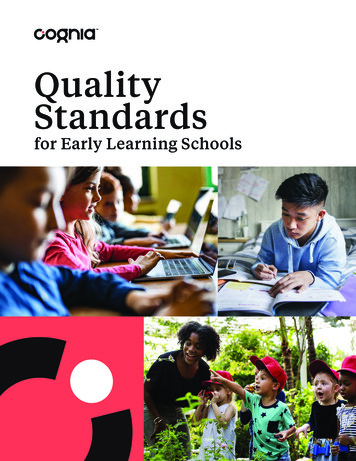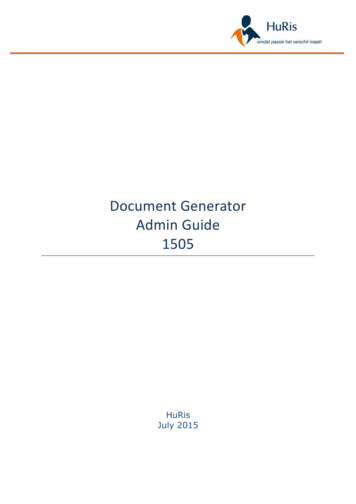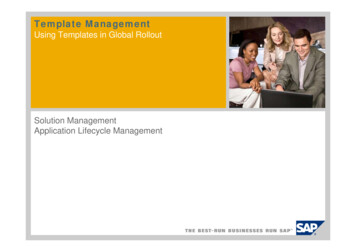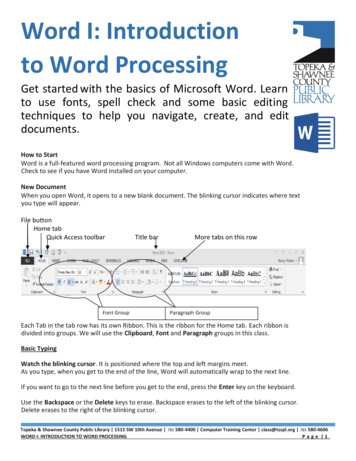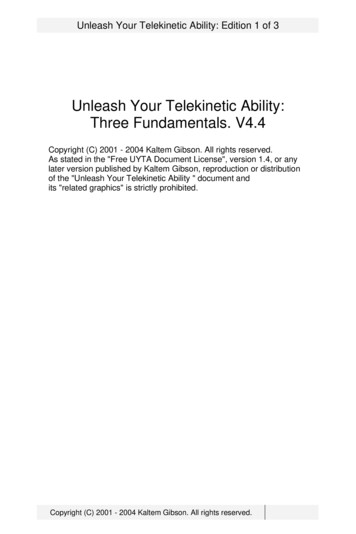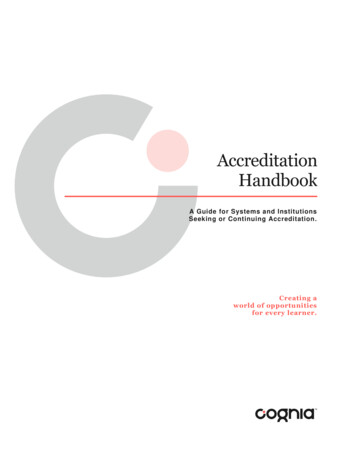
Transcription
AccreditationHandbookA Guide for Systems and InstitutionsSeeking or Continuing Accreditation.Creating aworld of opportunitiesfor every learner.
PrefaceThis guide is designed to help you understand the expectations of Cognia accreditation and to easily accessinformation about accreditation. The guide serves both systems and individual institutions that are continuouslyengaged in meeting accreditation policies, standards, and requirements. This handbook is strictly foraccreditation. Cognia offers additional guides specific to early learning and STEM (Science, Technology,Engineering and Mathematics), if those areas apply to your institution.We hope you find our ever-evolving accreditation policies, standards and requirements relevant to the currenteducation landscape and to your system or institution. As you progress through the handbook, we hope you alsogain a realization that our accreditation process is responsive to variations in the purposes (missions, visions) ofour education institutions. Above all, we hope your accreditation experiences through Cognia are relevantand meaningful on behalf of the learners you serve.Cognia accreditation represents the unified requirements for the North Central Association Commission onAccreditation and School Improvement (NCA CASI), the Northwest Accreditation Commission (NWAC), and theSouthern Association of Colleges and Schools Council on Accreditation and School Improvement (SACS CASI).Institutions and systems seeking to earn and maintain NCA CASI, NWAC, and SACS CASI accreditation mustcontinuously meet the Cognia accreditation policies, standards and requirements.Thank you for creating an opportunity for all learners and for your commitment to accreditation. We welcome andencourage you to contact Cognia at any time at cognia.org under the “Contact” tab. Cognia, Inc.Users may reproduce these materials for noncommercial, educational purposes only, provided all copyright and other proprietary noticescontained on the materials are retained. Unauthorized use of the Cognia logo is not permitted. 2020 Cognia, Inc. All rights reserved.i
Table of ContentsPreface . iIntroduction to the Accreditation Handbook . 3Cognia Accreditation Policies . 3Definitions . 3Introduction to Accreditation . 4Accreditation: Improvement Journey . 4Standards and Assurances: Systems and Institutions . 5Resources and Tools. 6The Improvement Journey: Engaging in Continuous Improvement . 6Role of the Facilitator . 6Key Responsibilities of Systems and Institutions . 7The Improvement Journey: Using Diagnostics and Tools . 9eProve . 9The Engagement Review . 12Off-site Preparation of the Engagement Review Team . 12Developing the Review Schedule . 12Key Components of the Engagement Review Schedule . 13Evidence . 14The Institution Overview. 15Activities Ongoing throughout the Engagement Review . 15Setting up Interviews . 16Classroom Observations . 17General Observations Around the Institution . 18Professional Deliberations . 18Preparing for the Concluding Meeting . 18Coordinating Team Logistics. 18Hosting the Engagement Review Team . 19Keys to a Successful Review. 21Continuing the Journey . 21The Written Report of the Engagement Review Team . 21Notice of Accreditation, Celebrating with the Community and the IEQ . 21Acting on the Engagement Review Team’s Findings . 22Conclusion . 23Accreditation Handbookv.2020.09.12
Introduction to the Accreditation HandbookThe Accreditation Handbook: A Guide for Systems and Institutions Seeking or Continuing Accreditation isdesigned to provide you with comprehensive information about the Cognia approaches to accreditation andcontinuous improvement and what they mean to your system or institution. The handbook organizes into onelocation your access to information, resources and tools for your system’s or institution’s journey of improvementand your participation in Cognia Accreditation Engagement Reviews. The handbook is organized into twocategories: Narrative descriptions of essential research, frameworks, policies, standards, requirements andapproaches to continuous improvement. This detailed information sets the stage and rationale for andcontinuous improvement through accreditation. Links to documents, resources, tools, and services to assist systems and institutions in yourimprovement journey and pursuit and maintenance of accreditation. The links are routinely updated.While you may access this information at any time, Cognia encourages you to download documents justbefore you need them to ensure you have the most recent version.Headings and subheadings will help you navigate to information pertinent to your interests and needs at the time.As always, Cognia welcomes your feedback and suggestions for making this handbook a more meaningful tool.Accreditation may be conferred to an institution or a system. For systems accreditation, all schools managed bythe system must be accredited or in the accreditation process. The system is granted accreditation in addition tothe accreditation that is conferred upon each institution. Throughout this handbook, the term institution is usedwhen referencing either the system or the institution.Cognia Accreditation PoliciesThe Policies and Procedures for Accreditation and Certification represent the unified policies and procedures foraccreditation and certification from Cognia and its accreditation divisions: the North Central AssociationCommission on Accreditation and School Improvement (NCA CASI), Northwest Accreditation Commission(NWAC), and Southern Association of Colleges and Schools Council on Accreditation and School Improvement(SACS CASI). Therefore, all references to Cognia in this handbook collectively refer to NCA CASI, NWAC andSACS CASI.Cognia maintains policies at all times that are available for public access on the Cognia website at cognia.org.As of July 1, 2015, any institution and system that is accredited by Cognia is awarded a seal that collectivelyreflects NCA CASI, NWAC and SACS CASI accreditation.DefinitionsThe accreditation policies and procedures provide definitions for performance. This handbook aligns with thesedefinitions as information is presented about accreditation. The handbook reflects accreditation only.Information about certification is presented in documents unique to the specific certification (for example,documents related to STEM Certification).1. Accreditation. A voluntary method of quality assurance, developed more than 100 years ago by Americanuniversities and secondary schools that is designed primarily to recognize institutions adhering to a set ofeducational standards and policies. Accreditation applies to an entire institution or system.3Accreditation Handbook
2. Certification. A voluntary process of quality assurance that yields a documented recognition ofachievement of a defined process or program. Certification may apply to a process or program of aninstitution or to an institution as a whole.3. Institution. Any educational unit such as a school, association, charter school authorizer, corporation orEducation Service Agency (ESA) that is seeking accreditation or certification as a single entity.4. System. Any organization such as a corporation, district, ESA, or system of institutions that is seekingaccreditation for the system as a whole, including the organization’s system-level and all of the institutionsmanaged by the system.The policies and procedures provide applicability requirements specific to systems and institutions andprocedural requirements to Cognia related to all aspects of accreditation recognition and management.ResourcePolicies and Procedures for Accreditation and CertificationIntroduction to AccreditationToday, accreditation is used at all levels of education and is recognized for its ability to effectively drive improvedstudent performance and continuous improvement in education.Systems and institutions seeking to achieve or maintain accreditation understand, honor and embrace theconcept of continuous improvement. These systems and institutions are engaged every day in a journey ofimprovement. They are dynamic and continuously evolving, with an unrelenting focus on becoming better onbehalf of the students they serve. They operate as learning communities by demonstrating healthy cultureswhere individuals collectively analyze practices and results, engage in professional learning and dialogue, takemeaningful action, and assume responsibility for results.Accreditation: Improvement JourneyAccreditation requires systems and institutions to continuously meet the applicable Cognia Policies, Standardsand requirements. Cognia refers to the collective efforts and actions of the institution to continuously meetaccreditation expectations as the improvement journey. Cognia accreditation is responsive to variations in thepurposes (i.e., missions and visions) of accredited systems and institutions. The improvement journey of aninstitution should progress in ways that are personalized, relevant and meaningful on behalf of the studentsserved.Periodically, Cognia will review the institution through on-site visitations that are specific to the purpose of thereview. Such reviews may include Readiness Reviews, Engagement Reviews, Monitoring Reviews, or otherSpecialized Reviews as discussed later in the handbook.4Accreditation Handbook
Standards and Assurances: Systems and InstitutionsContinuous improvement should be the goal of every institution. Cognia provides accreditation Standards andAssurances that are specific to varying types of systems and institutions. The improvement journey for eachinstitution may look different but should always include measures of quality of learning and instruction.The Performance Standards and Key Concepts provide a set of evaluative criteria that lays the foundation forimprovement planning and implementation. Based on rigorous research and best practices, the Standards are apowerful tool for driving instructional change. Cognia is committed to quality and to assisting the needs of theinstitutions we serve by providing varied and appropriate accreditation Standards and Assurances.The Assurances are compliance-oriented requirements of all accredited institutions. Assurances are comprisedof requirements applicable to all systems and institutions and, in some cases, supplemented by any additionalrequirements unique to the system or institution type. Also, some institutions may have specialized assurancesrelated to the institutions or to requirements of partnership agreements. If those apply, Cognia representativesconducting the Readiness Review will share that information with the institution.Resources System-level Standards and AssurancesSystem TypeStandards & Key ConceptsAssurancesCharter School AuthorizerCognia Performance Standards and KeyConcepts for Charter School AuthorizersCharter School AuthorizerAssurancesCorporation andCorporation SystemsCognia Performance Standards and KeyConcepts for CorporationsCorporation AssurancesCognia Performance Standards andKey Concepts for Education ServiceAgenciesEducation ServiceAgency AssurancesCognia Performance Standards and KeyConcepts for School SystemsSystem AssurancesEducation Service AgencySchool System(Public Districts, NonpublicSystems) Institution-level Standards and AssurancesInstitution TypeAssurancesDigital Learning AssurancesDigital Learning InstitutionsStandardsCognia Performance Standards and KeyConcepts for Digital Learning InstitutionsCognia Standards for QualityEarly Learning SchoolsEarly Learning AssurancesEarly Learning InstitutionsExtended LearningInstitutionsCognia Performance Standards forExtended LearningExtended LearningAssurancesCognia Performance Standards and KeyConcepts for Postsecondary InstitutionsPostsecondary AssurancesPostsecondary InstitutionsCognia Performance Standards and KeyConcepts for SchoolsCognia Performance Standards and KeyConcepts for Special Purpose InstitutionsSchool AssurancesSchoolsSpecial Purpose InstitutionsAssurances forAdjudicated YouthTravel StudyTutoringWilderness5Accreditation Handbook
Resources and ToolsCognia provides a wide range of useful services and tools to assist systems and institutions in yourimprovement journey and pursuit and maintenance of accreditation. The resources and tools are reserved forsystems and institutions that are members of the Cognia network and are accessible by logging into the Cogniawebsite at www.cognia.org/resources. Simply select the appropriate page for your type of institution to find therelated resources and tools.If you have any questions regarding the accreditation process, contact accreditationservices@cognia.orgResourcesCognia Network Resource Pages (for Cognia Network Members)Cognia Offices (Contact Us tab)The Improvement Journey: Engaging in ContinuousImprovementRole of the FacilitatorOften the leader of the institution assigns a senior staff member to facilitate the accreditation process. Thefacilitator: Serves as the key point of contact between Cognia and the institution Oversees the accreditation management for the system, including working with individual institutions withinthe system Supports stakeholders throughout the process, answers questions and provides guidance Works with the Lead Evaluator to prepare for and host the Engagement Review Manages the logistics and oversees the schedule of the Engagement Review6Accreditation Handbook
Key Responsibilities of Systems and InstitutionsAccreditation is based on a five-year term. Though the Engagement Review is a single event, that event isdesigned to measure the degree to which your institution is engaged in an ongoing improvement journey. Thefollowing table outlines the responsibilities of your institution.TimingEvery YearInstitution Responsibilities TimingYear of AccreditationEngagement ReviewMaintain membership in the Cognia Network.Engage in ongoing self-analysis and continuous improvement using the tools ineProve and/or other tools that support your efforts.Adhere to the Cognia policies, Standards and requirements.Analyze and document results of improvement efforts.Update system and institution demographic and contact information.Notify Cognia of any substantive changes (using the Cognia SubstantiveNotification Change Form) that may affect how your institution meets Cogniapolicies, Standards and requirements (link provided below).Institution Responsibilities Work with Cognia to schedule the Engagement Review dates.Work with the Lead Evaluator to establish the Engagement Review scheduleand make arrangements for the team.Host the Engagement Review Team.Act on the Engagement Review Team’s findings.Upload at least four weeks in advance of the Engagement Review, via the SharedFolder in eProve workspace, the following:o Cognia Assurances report(s) and evidences, as deemed required(complete in eProve diagnostic and send to the workspace).o Improvement plan/strategic plan based upon an analysis of studentachievement and organizational effectiveness (upload in eProvediagnostic or directly in the workspace).Cognia encourages you to complete, and upload the following: Performance Standards Worksheet(s) Evidences that inform the Key Conceptso Label your documents with the Standard number(s). For example: 1.1-Purpose and belief statements 1.4-Policies 2.5-2.6-Scope and sequence/analysis of student performance Analysis of perception data (e.g. eProve surveys) Analysis of experiential data (e.g. eProve inventories) Analysis of student engagement data (e.g. eProve eleot) Analysis of program data DemographicsRefrain from providing external links (e.g. Google Drive). Engagement ReviewTeams are not required to review any evidence provided through external links.7Accreditation Handbook
When applicable, the above evidence should focus on trend information, results, anddecisions made from the results. All evidences should be uploaded directly to eProveworkspace or via eProve diagnostics. As you continue to gather evidence andanticipate the Engagement Review Team, we recommend that you to refrain fromuploading the numerous guides, written curriculums, meeting minutes, and othersuch routine, operational documentation unless (1) the documents are specificallynamed in the Standards (e.g. Governing Policies) or (2) the documents reflect robustdecisions aligned to priorities (e.g. meeting minutes that document decisions andnext level actions for advancement or improvement plans).If you elect to engage with the School Quality Factors or System Quality Factors(SQF), you may access and submit the SQF in the eProve diagnostic. While westrongly urge you to complete and use the SQF to support meaningful dialogue, todrive continuous improvement in your institution, the SQF is not required for theAccreditation Engagement Review. The SQF questions are reflective for theinstitution and the summary narratives bring richness to understanding the institution,by both stakeholders and the Engagement Review Team.Refer to the Institution and System Evidence Guide for further evidence regardingpractices, processes and programs that are embedded in the organizationalpractices.TimingInstitution ResponsibilitiesAfter theAccreditationEngagement Review Review and discuss the findings from the Engagement Review with allstakeholders.Ensure that plans are in place to sustain the Standards rated as Impacting andthe strengths noted in the report to maximize their impact on the institution.Develop action plans to address the Standards rated as Initiating and findings ofthe report offered by the team. Include methods for monitoring progress in theaction plans and documenting improved performance in the Standards.Use the report to guide and strengthen efforts to improve student performanceand institution effectiveness.Continue to meet the Cognia Performance Standards and engage in continuousimprovement and document results.Resource Substantive Change Notification Form8Accreditation Handbook
The Improvement Journey: Using Diagnostics and ToolsCognia’s intent is for your institution to use appropriate tools for the diagnosis of your continuous improvementprocess. Your analysis of the results of these diagnostics will be critical not only to your ongoing improvementprocess, but also for your Engagement Review.eProve Cognia’s eProve diagnostic suite offers a comprehensive yet simple and convenient way of identifying yoursystem’s or institution’s strengths and challenges. Cognia created eProve to support your institution’simprovement planning framework and engagement in continuous improvement. The eProve system providesresources and tools for systems and institutions in collecting and analyzing information, developing informedimprovement plans, and managing continuous improvement processes. All systems and institutions in theCognia network have access to eProve and should use the tools in eProve regularly.Understanding and Leveraging eProve diagnosticsYour institution should engage in an ongoing internal review to determine the current status of yoursystem, including needs, goals and areas of successful improvement. During your improvement journey, yoursystem also should focus on collecting and analyzing data concerning (1) perspectives (stakeholderperceptions about your institution gathered through surveys, interviews or other techniques), (2) experiences(activities your stakeholders engage in on a regular basis) and (3) data analysis (ongoing collection, analysisand use of data, particularly concerning student performance and organizational effectiveness). Among themany diagnostics and surveys available in eProve, SQF diagnostics are designed to facilitate a collaborativeprocess of internal synthesis, analysis and reflection and assessment of your system's current reality. The SQFdiagnostics can be used as often as needed, as a reflective process.The Cognia Glossary of Terms provides definition for key terms and diagnostics related to the accreditationprocess.Conducting eProve surveys and inventoriesThe purpose and value of surveys is to gain an understanding of what key stakeholders believe about thequality and experience of schooling. Cognia provides an array of valid and reliable surveys that a system candeploy to learn and gather stakeholder perspective.The purpose of inventories is to gain an understanding of what key stakeholders experience within the schoolcommunity. Stakeholder experiences reveal how the processes, practices, and conditions of schooling impactlearners, parents, and educators.Observing Student Engagement using eProve eleot Student engagement of the learning environment is a critical school quality indicator. Through the EffectiveLearning Environments Observation Tool (eleot ), educators get a research-based instrument to learn andunderstand how learners engage the learning environment in their school. The results of eleot can inform andguide instructional design and delivery to improve the learner experience and performance. Systems andinstitutions that are currently accredited have access to eleot for their own use. Contact Cognia for additionaldetails and support.School/System Quality Factors in eProve diagnosticsWhile Cognia strongly urges you to complete and use the SQF to support meaningful dialogue, to drivecontinuous improvement in your institution and to support the review, the SQF is not required for theAccreditation Engagement Review. The SQF questions are reflective for the institution, and the summarynarratives bring richness to understanding the institution, by both stakeholders and the Engagement ReviewTeam.The SQF diagnostics are built on seven factors concerning change in a system’s culture, conditions,processes, practices and actions. The SQF is also an effective way for systems and institutions to organizeand focus reflections on their improvement journey. As an institution uses the SQF for the first time, staff9Accreditation Handbook
members are encouraged to become familiar with the SQF diagnostic through a review of the factors andquestions within the SQF.A review of the SQF will help you determine the information and data analysis you need to engage in a datadriven process of internal reflection and assessment of your current reality. This analysis and reflection willguide the identification of strengths and areas of need that provide the necessary data for successfulimprovement planning. In addition, the SQF enables you to add narrative insights or a summary related toeach of the factors. (The narrative is where your institution can capture what you have learned through theanalysis of data related to each factor.) You also will have the ability to add relevant attachments for eachfactor that would be useful for the system to use as a part of the ongoing improvement journey. If yourinstitution chooses to complete the SQF, Cognia recommends that your leadership team complete thediagnostic only after collecting and analyzing data from your other data sources, including the results ofsurveys, inventories and assessments.Purpose of eProve ToolseProve ToolPurposeSurveysTo gain an understanding of what key stakeholders BELIEVE about thequality and experience of schooling.InventoriesTo gain an understanding of what key stakeholders EXPERIENCE withinthe school community.Observation of LearningEnvironment (eleot)To observe student engagement in the learning environment.School/System QualityFactorsDiagnosticTo conduct a self-assessment of the practices and conditions that impactsthe quality of the system or institution community.Resources System Quality Factors DiagnosticSchool Quality Factors Diagnostic10Accreditation Handbook
Using Alternative ToolsCognia strongly encourages and expects systems and institutions to use certified, valid, and reliable tools andresources. Cognia Certified Content provides an institution with the ability to benchmark their results withsystems throughout the Cognia Improvement Network. Benchmarking is a valuable tool that provides systemsand institutions with the ability to understand their results in a greater context and gives access to theperformance and experiences of systems throughout the network.Cognia is committed to the customization and personalization of the improvement journey for each institution.As a result, Cognia offers institutions with three process options for gaining relevant stakeholder feedback thatis meaningful to the institution.Options for Systems and InstitutionsSystems and institutions have three options in the survey/inventory process, two of which include using theirown surveys or inventories as part of the Engagement Review. Only the third option requires institutions tonotify Cognia, via submission of the Notification of Alternative Survey or Inventory form. This form is availableat www.cognia.org/resourcesInstitutions can:1. Exclusively, use the Cognia surveys and inventories accessible in eProve and access reports of resultsthrough eProve.2. Use the Cognia surveys and inventories accessible in eProve and supplement the surveys/inventories withyour customized questions. You will have access to reports of results through eProve that include theCognia questions and your customized questions. The Cognia questions may not be altered or modified.You are not required to notify Cognia that the survey or inventory has been supplemented with customizedquestions.3. Exclusively, use customized surveys or inventories from sources other than Cognia. You may input thequestions into eProve and administer the instrument through eProve, or administer them externally. If youpost your instruments/questions in eProve, you will have access to reports of results through eProve.Under this option, you must submit the notification form below to Cognia by loading the form into theShared Folder of your eProve workspace no later than four weeks prior to your Accreditation EngagementReview.The goal of this process is not to dissuade you from using an alternative survey or inventory. Cognia wants toencourage all institutions to link their improvement efforts to data relevant to those efforts by using Cogniacertified content or an alternative.Resource Notification of Alternative Survey or Inventory11Accreditation Handbook
The Engagement ReviewThe
designed to measure the degree to which your institution is engaged in an ongoing improvement journey. The following table outlines the responsibilities of your institution. Timing Institution Responsibilities Every Year Maintain membership in the Cognia Network. Engage in ongoing self-analysis and continuous improvement using the tools in
